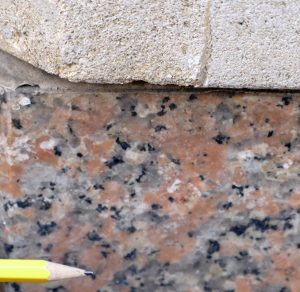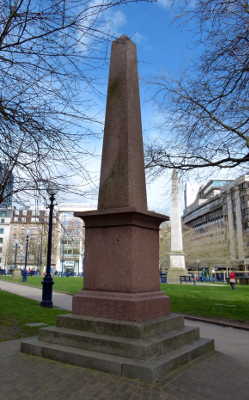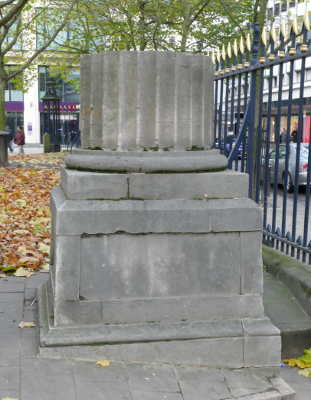Birmingham Building Stones Trails
Trail 1: From the Town Hall to the Cathedral continued
Cross over Colmore Row and continue to No. 57, at the junction with Church Street.
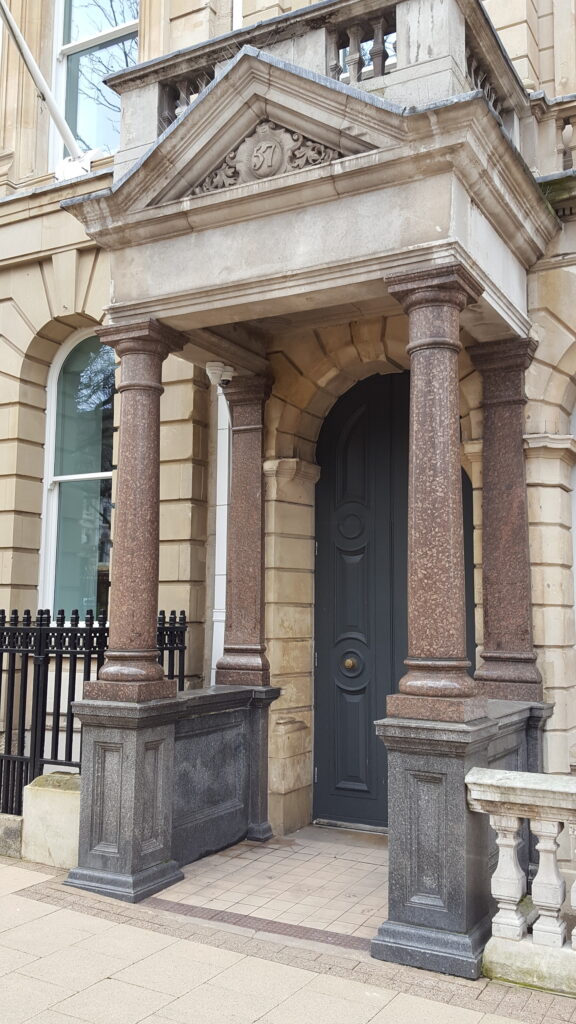
57 Colmore Row
The entrance porch to No. 57 is immediately striking for its colourful pillars. These are examples of Shap Granite which comes from Shap Fell in the Lake District. This is the ‘dark’ variety with a rich red-brown matrix and prominent, euhedral phenocrysts of pink, potassic feldspar. It is a late Caledonian granite, intruded around 397Ma into the Borrowdale Volcanics Group and the overlying Windermere Group. The quarry has recently reopened (November 2014) after a long period of inactivity and is currently being worked by the Armstrongs Group. The quarry has a reserve of 20 million tonnes of stone and valid planning permission for mineral extraction until 2042, so this famous decorative stone is once more available to the market.
The plinths supporting the Shap granite columns on either side of the porch are made of Cairngall Granite quarried near Peterhead in Aberdeenshire. This dark grey granite, like the Rubislaw granite at No. 84, dates from the early part of the Caledonian orogeny around 470Ma. It is famous as the source of the largest flawless block of worked granite ever produced in Britain. This was extracted and fashioned in the construction of the double sarcophagus for Queen Victoria and Prince Albert at the Royal Mausoleum in Windsor. The main fabric of the building is another example of Bath Stone, and the balustrade is made of Portland Whitbed. Both are oolitic Jurassic limestones, here showing to good effect the contrasted colour of the two stones.
Cross over Church Street to Gusto restaurant (below the Grand Hotel complex)
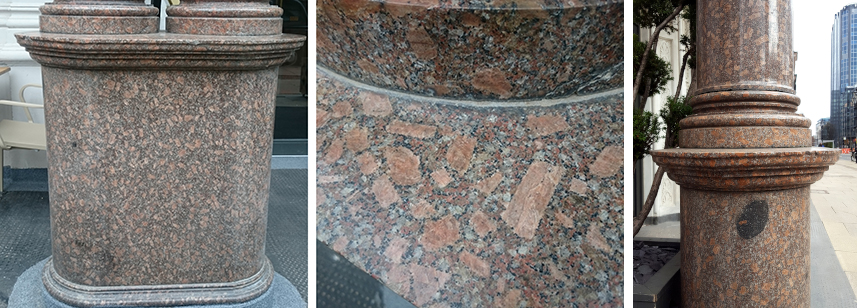
Shap Granite at Gusto Restaurant – note the xenolith in the right-hand photo
17. Gusto Restaurant (below the Grand Hotel)
The Grand Hotel was built in 1878 by architect Thomas Plevins. The lower storey is rendered, and it is probably Portland Stone Whitbed above and around the doorway. Of greatest interest, however, are the granite columns supporting the porch. These are further splendid examples of Shap Granite. On each side there are twin columns standing on a single plinth with an ovoid section. These were probably added to the façade in 1890 during a refurbishment by Martin & Chamberlain. There are some spectacular inclusions which, at first sight, appear to be examples of ‘xenoliths’. These are fragments of rock which fall into granite magma and stay intact as it solidifies. However, closer inspection reveals that some of these contain phenocrysts of the pink feldspar, showing that the inclusions are in fact ‘enclaves’. These are patches of mafic magma which, in this case, have captured some lone feldspar phenocrysts but have remained unmixed with the dominant granite mix as it cooled. Xenoliths or enclaves were known as ‘heathens’ to the quarrymen and stonemasons.
Walk to the end of the block, at the corner of Colmore Row with Livery Street. Another modern building is occupied by Barclays Bank.18. Barclays, 15 Colmore Row
A yellow, calcarenitic facies of Bath Stone is also used to clad this building. Close inspection with a hand lens shows the rock to be composed of finely comminuted shell fragments as well as ooids. However the steps are of a pink granite, possibly a variety from Sardinia or from north-western Spain. Further research would be required to confirm the origin of this stone. It is composed of pink-orange potassic feldspars, white plagioclase, greyish quartz and black biotite.
19. Cathedral Church of Saint Philip
The Church was designed and built by Thomas Archer, a rare and well-executed example of ‘English Baroque’. Initial building works were completed in 1715, with the tower added in 1725. Thomas Archer and his brother Andrew were local gentry and landowners who initially supplied the stone from quarries on their own land. This was Arden Sandstone from Rowington Quarries which decayed rapidly. Refacing the Cathedral began in 1859, and now all the exterior stone was put in place in the 19th and 20th Centuries. The stone used is a variety of buff to white-coloured sandstones from Derbyshire and the Midlands; these include Darley Dale Sandstone as described above, White Mansfield Stone, White Hollington Stone and Dunhouse Stone (Jones, 2011). However, as at the Council House, distinguishing these stones on the building is no easy task. White Hollington Stone is a buff coloured sandstone from the Triassic strata of Staffordshire, part of the Sherwood Sandstone Group. It is still produced from Tearne’s Quarry near the village of Hollington. Dunhouse Sandstone is another buff sandstone from the Millstone Grit Group, but this time from Cleatlam, County Durham. Both these sandstones are quartz arenites with flecks of mica.
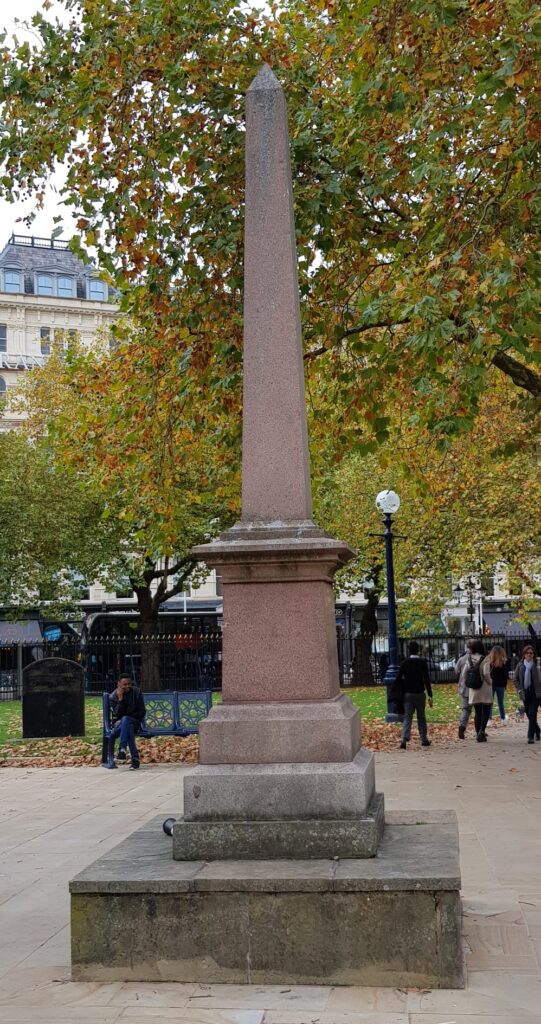
Henry Buck Memorial
20. Henry Buck Memorial
Though it may seem out of proportion for such a grand memorial to be erected in honour of the ‘Grand Master of the Manchester Order of Odd Fellows’, our purpose is to examine the attractive salmon-pink granite used to construct this obelisk. This is Corrennie Granite, a medium grained biotite granite from the district of Tillyfourie in Aberdeenshire. It is around 450Ma and another example of the wide range of Scottish granites emplaced during the Caledonian orogeny. The obelisk rests on an unspecified sandstone base.
Proceed round the east end of the Cathedral, noting the colourful patterns in the paving as you go. This is York Stone showing some spectacular liesegang banding (as described at Stop 2). This machine-cut paving was laid during refurbishment of the Cathedral church yard in 1999, replacing the previous York stone paving slabs which had a more uneven texture. Head diagonally across the Square towards the red granite obelisk to the south of the Cathedral.
21. Crimean War Memorial Obelisk
This red granite obelisk was designed to commemorate the Crimean War and also Lieutenant Colonel Unett who was killed at Sebastopol. Thomas Unett was born in Handsworth and christened in St Philip’s. The monument was probably installed soon after Unett’s death in 1856. The Memorial is constructed of Peterhead Granite, quite possibly the most popular stone for monuments used in the Victorian Period. It is a distinctive medium to coarse-grained, pink granite with grey, smoky quartz, pink feldspars, hornblende and biotite. It commonly contains rounded enclaves of a dioritic, mafic igneous rock, and several are present in this monument. Peterhead Granite is quarried from Stirlinghill to the north of Aberdeen, on the coast. The quarries were in operation for around two hundred years, finally closing in 1956. The Peterhead Pluton was intruded in the Devonian period towards the end of the Caledonian Orogeny at around 406Ma.
22. Burnaby Obelisk
23. Monument to John Heap and William Badger
Heap and Badger were builders working on the construction of Birmingham Town Hall and they were both killed by a falling pedestal whilst working on the construction in 1833. Their monument here is the curtailed shaft of a fluted column, modelled on those used at the Town Hall, and the memorial contains the stone which killed them. Like the Town Hall itself this monument is constructed from Penmon Marble from Anglesey, poignantly linking together the start and finish of this trail. Fittingly, this monument is the focus for International Workers Day on 1st May each year.
The Cathedral churchyard is the final stop on this walking tour. The southern side of Cathedral Yard, Temple Row, is covered in the third and final trail in this series of geological walking tours of Birmingham’s city centre: ‘Around the Shops’.
This is the last page of Trail 1.
References:
- Foster, A. (2007), Birmingham. Pevsner Architectural Guides. Yale University Press, Newhaven & London. 326 pp.
- Noszlopy, G. T. & Waterhouse, F. (2007), Birmingham: Public Sculpture Trails. Liverpool University Press, Liverpool. 191 pp.
- Schroder, J.K., Schroder, J. & Robinson, E. (2015) Building Stones Detective Trail. University of Birmingham Lapworth Museum of Geology. 2 pp.
- Shilston, P. (1994), Building Stones of Birmingham City Centre, ESTA conference Field Workshop Handbook, Birmingham University, Black Country Geological Society; Revised by Julie Schroder 2016. 7 pp.
- Walkden, G. (2015a), Devonshire Marbles: their geology, history and uses. Volume 1. Understanding the marbles. Geologists’ Association Guide no. 72. The Geologists’ Association, London. 1-232.
- Walkden, G. (2015b), Devonshire Marbles: their geology, history and uses. Volume 2. Recognising the marbles. Geologists’ Association Guide no. 72. The Geologists’ Association, London. 233-484.
- National Portrait Gallery: http://www.npg.org.uk/collections/search/portrait/mw00932/Frederick-Burnaby
The reproduction of the portrait of Frederick Burnaby by James Jacques Tissot, NPG 2642, was made available for use here by the National Portrait Gallery via a creative commons licence http://creativecommons.org/licenses/by-nc-nd/3.0/
The maps are taken from OpenStreetMap. OpenStreetMap® is open data, licensed under the Open Data Commons Open Database License (ODbL) by the OpenStreetMap Foundation (OSMF). For further copyright details see http://www.openstreetmap.org/copyright

